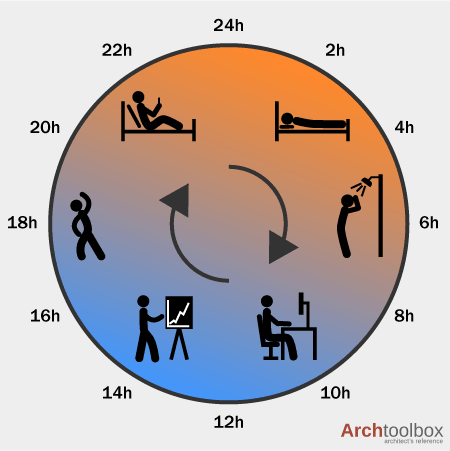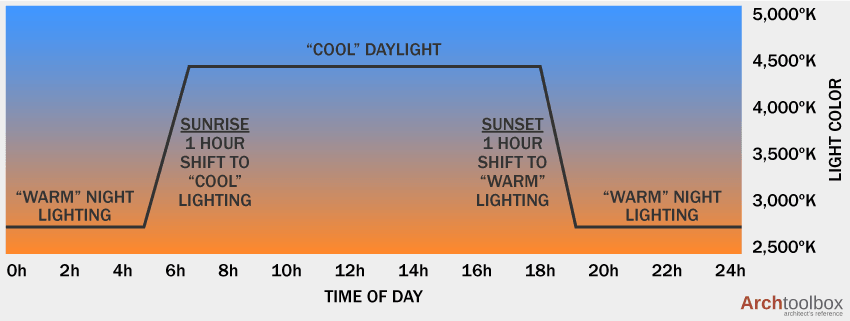With advances in LED technology, a new category of product is now available to combat the disadvantages of our predominantly indoor lifestyles — enter circadian lighting.
At the biological core of human beings, animals, and even plants is the phenomenon of the circadian rhythm, which is a series of physical, mental, and behavioral changes that run over a 24-hour period. These cycles respond to light and dark and are vital to functions like cell regeneration, hormone production, and brain activity.
Sleep is one of the cycles governed by the circadian rhythm. Coinciding with the sun, your body naturally wants to be awake during the day and asleep at night.
In today’s world though, humans spend a majority of their time indoors, which makes it challenging for our bodies to connect to the natural cycle of daylight and darkness. The artificial light commonly found in homes and commercial settings is low-quality and does not support a healthy circadian rhythm.
What is Circadian Lighting?
Also referred to as tunable lighting or human-centric lighting, circadian lighting’s aim is to promote the natural circadian rhythm in our bodies by mimicking the light/dark cycle. These types of LED lighting products shift the color and intensity of the light to simulate the sun’s behavior — soft and warm in the early morning and early evening, and cool bright light at midday.
Researchers have discovered that blue light is the most important factor in synchronizing the circadian rhythm. A photopigment in the eye called melanopsin, which indirectly affects production of the hormone melatonin, reacts at its highest level to light at 490 nm (wavelength), or the most saturated value of blue light. Cool, blue light has been shown to suppress melatonin levels, which is optimal for daytime as melatonin plays an important role in promoting sleep.

Exposure to blue light in the evenings, though, is less than ideal. It can affect sleep quality, sleep cycle duration and even has the potential to cause other health issues, like glucose intolerance. Instead, warmer light for evenings is the answer. Yellow/orange hues with less blue content promote relaxation, making it easier to wind down at nighttime and get a good night’s sleep.
How Does Circadian Lighting Work?
Circadian lighting works by manipulating a light’s color temperature via color tuning and its brightness via intensity tuning to mimic the sun’s light cycle.

Color Temperature vs Light Intensity
Color temperature (CCT) describes the color appearance of the light, measured in a scale of degrees Kelvin (K) from 1000-10,000. Less than 2000K is a warm-hued amber light, close to candlelight; 5200K is daylight; and 6500K and up is bright, blue light.
Light intensity is measured in lumens, which is a measurement of brightness. The higher the lumens, the brighter the light; low lumens are appropriate for early morning and evenings, while higher lumens are suited for the middle of the day. Lighting levels in buildings vary by space use and occupant preference.
As a side note: Lumens are not to be confused with watts, which are a measurement of the amount of power used by the bulb. For comparison, though, a 100W incandescent bulb emits 1600 lumens, while a 14W LED emits approximately the same lumens.
Tunable Lighting Control
Circadian lighting products give the user or building manager the ability to tune the light, utilizing specific color temperatures and intensities throughout the day to promote an optimum circadian rhythm for a healthy wake/sleep cycle. In most cases, this requires a robust commercial lighting control system, but some consumer products are coming on the market to make circadian lighting possible in homes.
The Lighting Research Center at Rensselaer Polytechnic Institute, considered the premier organization for lighting research, introduced a metric in 2016 called circadian stimulus (CS) as a way for professionals to easily apply circadian lighting to interior environments.The CS value of a specific lighting environment is determined by the color and intensity of the light, the timing and duration of exposure, and photic history (previous light exposures).
And, while traditional lighting design is based on the amount of light illuminating a specific plane, circadian lighting requires light to be effectively distributed through the cornea of the occupants to stimulate the circadian system.
Benefits of Circadian Lighting
If installed and implemented correctly, circadian lighting has been shown by research to make a positive impact on the human experience indoors. Some benefits include:
- Increased productivity: Cool, blue light during the day promotes increased concentration and alertness.
- Improved mood: When it’s dark or cloudy, do you notice a correlation with your mood? Appropriate lighting during the day helps boost positive feelings.
- Improved sleep: Bright light during the midday and warmer light in the early evenings will promote healthy sleep patterns.
- Improved vision: Appropriate light levels are essential to seeing clearly without strain, especially as we age. Tunable white light that can be adjusted is key.
- Cost- and energy-effectiveness: Although the initial investment is higher, LEDs cost much less to operate and use significantly less energy than incandescent lighting.
What Color Light Helps You Sleep?
We know light has a huge impact on our circadian rhythm, and therefore the quality of our sleep. But what does science say about what color light helps you sleep?
As stated earlier, most research points to the positive effect that blue light has on our midday hours, and the negative effect it has at nighttime. Dim, yellow/orange-hued light is what’s most accepted as the ideal light for evenings and early mornings. And for sleep? Red!
Red light has little to no effect on circadian rhythm or melatonin production, so it’s perfect to use at night for a night light. Also, red light has been shown by recent research to help you wake up more refreshed the next day.
On the other hand, additional research published recently found that the brightness of the light mattered more than the hue of the light when it came to supporting the circadian rhythm of the mice being studied. This suggests that as long as blue light is dimmed, it may not be as detrimental as initially thought.
The jury is still out, but further research is sure to provide more definitive answers in the future.
Circadian Lighting Products
The market for circadian lighting products continues to grow as technology improves and more research supporting its benefits emerges.
Consumers can purchase standalone lamps that mimic the temperature and intensity of optimal daylight. Tunable light bulbs and lamps, those in which you can adjust the color temperature and brightness via an app, are also available. However, in order to get the full benefit the blue daylight wavelength must hit 490-nanometers — many daylight bulbs produce wavelengths as low as 420nm while claiming to mimic daylight.
Lastly, there are advanced tunable lighting control systems mostly used in commercial settings. Beyond custom control, these systems can enable the adjustment of light levels and temperatures automatically according to the time of day to follow the circadian rhythm, or can even be pre-programmed to adjust based on different activities.
These systems, as well as tunable lighting, come at a price though. A basic tunable table lamp for the home costs under $100, while an advanced system for a small office could easily cost tens of thousands. However, when viewed as an investment for better health with cost and energy benefits in the long run, more people are making the commitment.
The Bottom Line
Circadian lighting, which is aimed at promoting healthy wake/sleep cycles in our predominantly indoor world, has many proven benefits. By adjusting the color temperature and brightness of light, a user can mimic the sun’s rising and setting behavior, which has been shown to increase overall wellness. This product category will continue to expand as additional research is published, so expect to see new offerings at more attainable price points in the future.


